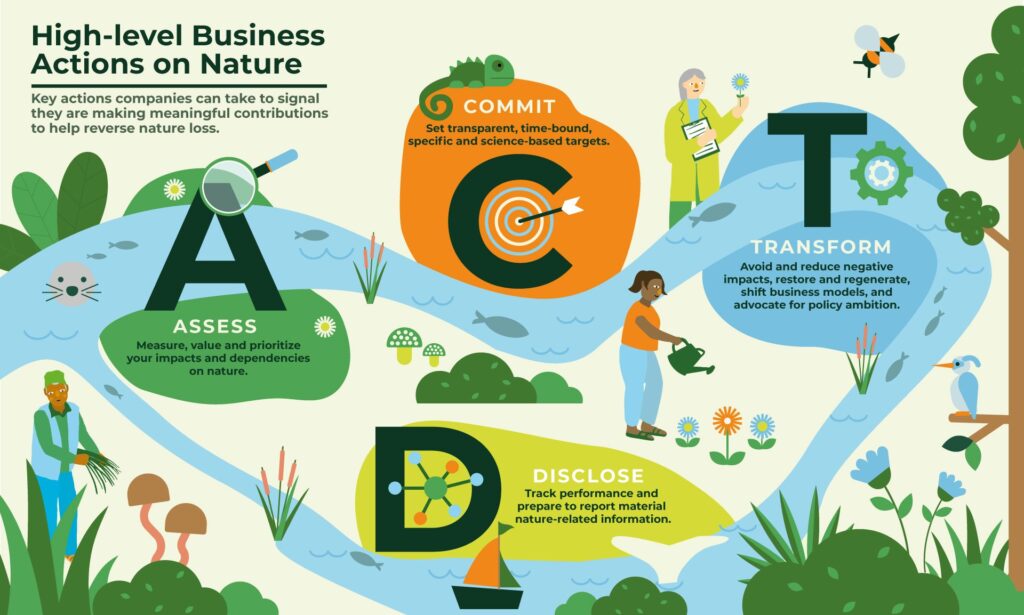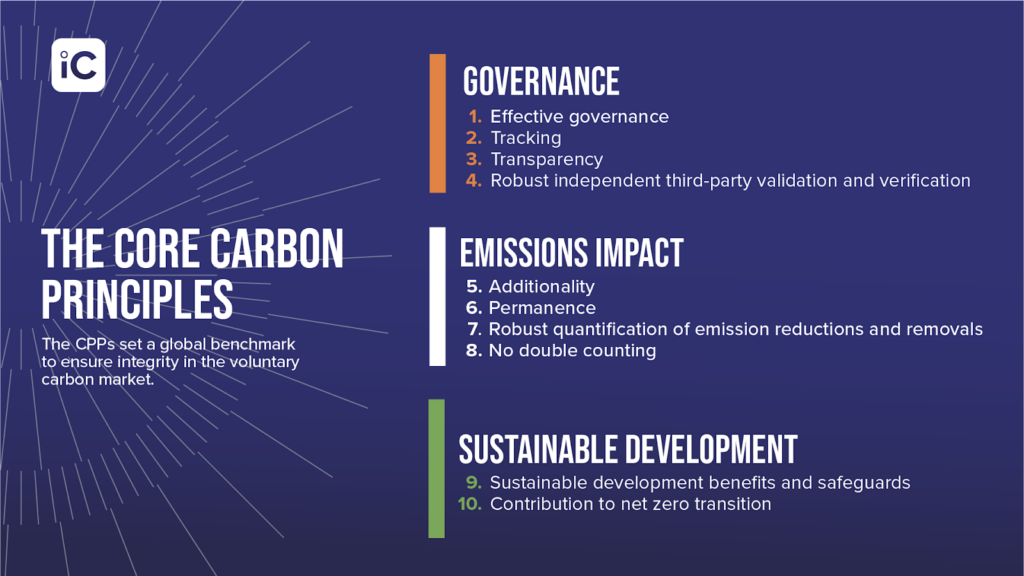Celebrating Biodiversity Day!
In order to streamline the space for businesses, leading organizations have joined forces to develop a series of high-level business actions on nature. We break it down for you in this article.

ACT-D: High Level Business Actions on Nature
The ACT-D high level business actions on nature were developed in a collaboration by leading organizations including the Capitals Coalition, Business for Nature, WBCSD, TNFD, Science Based Targets Network, WEF and WWF.
ACT-D guides businesses through the various tools, frameworks and initiatives available in the market to support them in assessing their relationships with nature, committing to action and target setting, transforming their practices and disclosing nature-related information.
Assess, Commit, Transform and Disclose
The high-level actions are divided into four key pillars: Assess, Commit, Transform and Disclose. Let’s explore each one of them.
🔎 Assess
Measure, value and prioritize your impacts and dependencies on nature to ensure you are acting on the most material ones.
Conduct an initial materiality assessment to prioritize efforts: Ensure you will be working on your most material impacts and dependencies on nature by performing materiality assessments across the production and consumption value chain – from extraction of raw materials to post-consumer waste. Using guidance from SBTN, companies can identify and manage priority environmental impacts, dependencies, and locations. For example, you may realize that the biggest impact your company has is indirectly through freshwater use from your suppliers and/or consumers.
Measure and value impacts and dependencies on nature. Build on your initial materiality assessment and conduct your own natural capital assessment by following the Natural Capital Protocol. Find the right tool to assess your impacts and dependencies through the Natural Capital Toolkit and where relevant, apply supplementary guidance on finance, biodiversity and food systems. Get in touch with We Value Nature to build your skills and capacity along your natural capital journey.
Evaluate business risks and opportunities, From understanding your impacts and dependencies on nature, identify and assess your company’s nature-related risk. Use the guidance provided by the Taskforce on Nature-related Financial Disclosures (TNFD) to show how your organization evaluates and manages nature-related risks. Identify priority locations for target setting and action using tools like the Integrated Biodiversity Assessment Tool (IBAT) for Business and dig deeper into particular risks and opportunities you have identified, for example by using the WWF Water Risk Filter.
Expand your assessment to include nature, climate, and people: Where possible, conduct an integrated assessment, including natural, social, and human and produced capital. Measure, manage and report on your climate impact through the GHG Protocol. Perform assessments of impacts and dependencies to capture the implications for indigenous people to ensure the protection of their rights.
🎯 Commit
Set transparent, time-bound, specific, science-based targets to put your company on the right track towards operating within the Earth’s limits.
Make commitments. Make meaningful, informed, and public commitments through credible platforms. Work to reduce your most significant and material business impacts and dependencies on nature while building environmental management and performance into your corporate governance. Use Business for Nature’s commitment list to locate relevant commitments and connect your company’s efforts to collective global action. Monitor, report and improve on progress towards commitments and targets, and use best practice ESG (Environment Social and Governance) metrics, making sure to incorporate relevant contextual information (such as the population density where air pollution occurs).
Set targets. Measure your baseline impacts and set measurable targets across priority locations for how much you will contribute to reduce your impact and contribute positively by restoring ecosystems, including land, freshwater and oceans. Ensure that targets are based on science, and reflect priority impacts and dependencies for your company, your region, and the planet. Take inspiration from the Science-Based Targets for Nature (SBTN) initial guidance and their suggested interim targets, and prepare to set targets in line with the final guidance to be released in 2023. Depending on your company’s material impacts, you should set initial targets using, for example, the Accountability Framework Initiative and this guide to setting water targets. For most companies, setting science-based targets for climate (through SBTi) is one of the best things you can do today in order to get ready to set SBTs for nature, and start contributing towards reducing the pressures fueling nature loss. Be as ambitious as possible and aim to achieve nature-positivity – alongside carbon neutrality – across your operations by 2030. Monitor, report and improve on progress towards commitments and targets.
⚙️ Transform
Avoid and reduce negative impacts, restore and regenerate, collaborate across land and seascapes, shift business strategy and models, and advocate for policy ambition
Avoid and reduce. Prevent impacts from happening in the first place or eliminate the impact entirely. Do as much as possible to minimize impacts across your value chain when elimination is not possible.
Stop any damage in priority areas to have “zero harm” on biodiversity and nature, such as the Amazon rainforests and coral reefs, while simultaneously acting to draw down impacts across less-threatened landscapes and ecosystems. If you are aware of certain practices that harm biodiversity (e.g., the application of fertilizers and pesticides, use of ghost nets and bottom trawls), take immediate action to change them, even if you don’t yet have perfect information.
While it is critical to address material impacts as soon as possible at landscape or seascape-level, many companies start by taking simple first steps to motivate employees and lay the groundwork for further action. While more strategic decisions are discussed and made, in parallel you can start by making meaningful gestures such as switching to renewable energy sources, increasing water use efficiency, removing single-use plastics from the office, recycling waste, planting native and pollinator-friendly species, and installing nesting boxes for birds and bees in areas around your operations. However, be sure that these first steps lead to widespread action to address the most material impacts and dependencies across your value chain.
Regenerate and restore. Actively work in collaboration with others within your operations and across value chains to restore ecosystems, including forests, soils, freshwater systems, and marine environments. Invest in nature-based, inclusive, and holistic solutions, which also capture carbon and improve livelihoods. The NBS benefits explorer is a great starting tool for companies who want to invest in nature-based solutions. Adopt best practices in context-based and collective stewardship by understanding local risks and opportunities and working with other local natural resource users (e.g., freshwater users in a landscape) and local authorities.
Follow the IUCN Global Standard for Nature-based Solutions which is a widely accepted reference that ensures a holistic approach is taken when using nature-based solutions for nature (including biodiversity, water), climate (including carbon sequestration and climate adaptation) and people (including livelihoods and community well-being). Support enforcement of local community and indigenous rights, and respect Indigenous People’s right to Free, Prior and Informed Consent.
Shift business strategy and models. Adapt your company strategy and business model to be “net-positive,” to “give back more than you take” to restore ecosystems with collective measurable, reported and verified positive impacts, while also ensuring your negative impact footprint is as low as possible. Embed nature at the core of your business: ensure that the value of biodiversity and climate impacts are weighed in critical decisions. Invest in transformational innovations and circular business models and products, such as buildings that absorb and break down pollutants. Engage in landscape-level and jurisdictional approaches for collaborative action to reduce impacts like deforestation and produce positive changes through contextually appropriate investments in nature-based solutions. Divest from assets – including in your pension plans – that degrade and over-exploit nature and redirect resources towards sustainable use, resilience, restoration, and circularity.
Encourage further business action – and thus the transformation of global economies – by making your methods and data open-source and sharing your successes and challenges with companies that are starting their journey. Elevate the World Economic Forum’s 15 nature-positive transitions which could generate up to US$10.1 trillion in annual business value and create 395 million jobs by 2030.
Collaborate with your value chains at the landscape-level. Act systematically to apply the mitigation hierarchy beyond operations and engage with key stakeholders, including those in your corporate value chain, in the landscapes and seascapes where you operate or source, and in your sector. Downstream companies, (those closer to consumers), should engage and support companies further upstream in their supply chains (those closer to raw extraction and production) to adopt lower impact practices, improve data collection abilities, and increase overall supply chain transparency.
Advocate for ambitious government policies that will scale and speed up further positive business action.
Sign up to the “Nature is Everyone’s Business” Call to Action, and support the Leaders’ Pledge for Nature.
Call on governments to adopt policies which create a stable operating environment and level playing field for business and contribute to key negotiations for nature. At the UN Convention on Biodiversity (CBD) COP15 negotiations world leaders have a unique opportunity to adopt a transformative international agreement on nature (the nature equivalent of the Paris Agreement on climate).
Support specific business advocacy initiatives that contribute to reversing the loss of nature, e.g., business manifesto calling for a UN treaty on plastic pollution.
📊 Disclose
Track performance and prepare to publicly report material nature-related information throughout your journey.
Monitor your progress regularly with the frequency appropriate for your nature commitments. E.g. quarterly monitoring may be appropriate for some targets such as water use or pollution discharge while 3 to 5-year monitoring may be appropriate for other targets such as species abundance.
Report progress made towards nature positive goals and communicate findings with key stakeholders throughout the process. Frameworks such as the Taskforce on Nature-related Financial Disclosures (TNFD) recommend that that business leaders communicate:
Governance: the ways in which the organization’s oversight and decision-making functions take nature-related risk and opportunities into account.
Strategy: the integration of actual and potential effects of nature-related risks and opportunities on the organization’s business model, strategy, and financial planning.
Risk management: how the organization integrates nature-related risks into its overall risk management approach.
Metrics and targets: quantitative and qualitative performance indicators and aims related to nature-related risk and opportunities, based on nature dependencies and impacts.
Seek out independent validation of processes and verification to enhance credibility of actions. Seek independent validation and verification to assure the company’s processes used for value chain mapping, materiality assessments, prioritizing locations for action, gathering baseline data and setting targets.
Align reporting with major reporting standards. As much as possible, ensure alignment with existing reporting standards, such as GRI, SASB, IFC, and the EU Non-Financial Reporting Directive, as well as with environmental data aggregators like CDP.
Wrap Up
International Biodiversity Day serves as a reminder of the critical importance of delivering on the ambition of the Global Biodiversity Framework as well as the role that the business and finance communities must play in this process.
It is not just a framework for biodiversity, but one for collective societal action.
By leveraging the guidance outlined in the high-level business actions on nature, businesses can begin to contribute meaningfully to reversing nature loss and to delivering a sustainable future.


